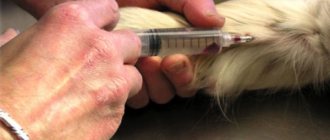During their short lives, hamsters are susceptible to various diseases and injuries. The physical suffering of hamsters during illness and old age is a huge psychological stress, especially for young children. To stop the suffering, there is a humane, but morally difficult way for animal owners - euthanasia.
Methods of euthanasia
One of the methods of euthanasia is the use of ammonia and alcohol solutions, which cause respiratory arrest when injected into the pulmonary lobes.
The method is used to euthanize puppies (up to 10 days old). If, in the opinion of the dog owner, this method is inappropriate, he should receive detailed advice from a specialist who will select immediate and painless drugs. Possible means of euthanasia:
- sedatives, which in large quantities act as a depressant on respiratory function;
- painkillers that reduce physical activity;
- relaxants for intramuscular administration;
- agents that regulate the balance of electrolytes in the body (an increased dose leads to cardiac arrest);
- conducting a powerful current discharge through the animal’s body, which leads to cardiac arrest.
Diarrhea in a dog: treatment at home
2.1
Injections
Detailed list of medications with names:
| Group of drugs | Possible options |
| Anesthetics |
|
| Sedatives | Xylazine is a drug for euthanasia with anesthesia: when administered, it relaxes muscles, lowers blood pressure, and depresses respiratory functions. |
| Muscle relaxants |
|
| Agents that affect electrolyte balance | Magnesium sulfate: when administered, blood pressure decreases, muscles lose strength, breathing stops, causing the heart to stop |
Constipation in a dog: causes and help at home
2.2
Sleeping tablets
Sleeping pills are slowly absorbed into the blood, so they can cause convulsions, paralysis, and poisoning. Tablet medications are not typically used by veterinarians.
In the Russian Federation there are no certified means for euthanasia of animals, which are sold in veterinary pharmacies without a prescription. For the purpose of temporary euthanasia, pharmacological drugs intended for humans are acceptable: Seduxen, Sibazon, Relanium, Diazepam, Phenazipam, their analogs; as well as drugs approved for dogs: “Cat Bayun”, “Stop-stress”, Amitriptyline, plant-based barbiturates.
Causes of inflammatory diseases
Hamsters use their cheek muscle cavities to ensure their normal functioning. Since they can obtain food only during the warm period of the year, the animals need to take care of significant supplies for the winter in advance. For this purpose, rodents use their cheek pouches, carrying grains and seeds into their bins. Animals in natural conditions will not put any other objects into their bags. Therefore, inflammation of the cheek pouches in wild hamsters almost never develops. At home, the animal is not threatened by predators, but sometimes close contact with a person is worse than a collision with a hungry animal.
The most common causes of inflammation are:
- The presence of sticky substances and sweets in the rodent’s diet. If the bags, which contained even a small amount of food, stick together, suppuration will certainly begin. Therefore, you need to make sure that chocolate, honey, sweets and other products that are undesirable for the animal to eat do not get into the hamster’s mouth. Human treats do not bring any benefit to rodents; for them, what is tasty is grain; the desire to feed a hamster chocolate is a common manifestation of selfishness.
- Having access to sharp objects. Even sharp sawdust can cause harm if the hamster manages to stuff it into its pouch. Sharp plastic and metal are even more dangerous. The damaged surface of the muscle cavities easily becomes infected.
- Consumption of large-fraction roughage. Too large particles of food also often provoke inflammatory processes and, in advanced cases, lead to loss of bags.
Humane euthanasia for a hamster
Tamed hamsters are very convenient for keeping in a city apartment. These miniature and funny rodents are often found in families with children. And it’s not surprising, since these cute creatures have a submissive disposition, they are safe, non-aggressive and very easy to care for. They are also interesting to watch, you can play with them and even train them.
However, the average lifespan of hamsters is short and ranges from 2 to 6 years. At this age, they already have some kind of disease or suffer from weakness and helplessness. This is why many people come to a difficult but correct decision - euthanasia. This practice is considered throughout the world the most humane way to relieve a pet from pain and other consequences of old age.
When is it necessary to euthanize a hamster?
Responsible veterinarians resort to euthanizing an animal only if there are serious reasons for this that cause it suffering, and also if there are no possibilities at all to save the pet.
Indications for euthanasia may include:
- Malignant tumors that cannot be treated. Tumors are accompanied by severe pain, metastases and ultimately kill the pet. In addition to formations, there may be other diseases that cannot be cured.
- Various injuries that worsen the quality of life: spinal fracture, damage to internal organs, traumatic brain injury.
- Birth defects or diseases that cause constant suffering to the hamster.
- Aggressive behavior that threatens the health and safety of the owners. This may be a consequence of various disorders of the nervous system or brain.
- Old age and its accompanying symptoms: weakness, inability to move, eat, pain and others.
Only a veterinarian can correctly assess the situation and make the correct diagnosis. Therefore, before deciding whether to euthanize your hamster, you need to contact several specialists. And if they agree that this is the only way to alleviate the suffering of the animal, then it would be appropriate to resort to euthanasia.
How does the euthanasia procedure work?
Euthanasia of a hamster is carried out in stages.
The first stage is the introduction of anesthesia, which blocks the functioning of the animal’s central nervous system. Thanks to this, the hamster falls asleep and does not feel anything. After a few minutes, the veterinarian can begin the second stage. At this time, you can say goodbye to your pet.
The second stage is the introduction of a special drug that stops the heart. The doctor declares death and after that the animal’s body can be sent for cremation at a veterinary center, or the owner himself will decide the issue of burial.
To ensure that the procedure is humane and the animal does not die in agony, a professional doctor always uses painkillers.
Pros of hamster euthanasia at home
Calling a veterinarian to your home for this purpose has a number of advantages:
- there is no need to take an animal in serious condition to the clinic;
- the pet feels calmer in a familiar environment next to the owner;
- the doctor can arrive at a convenient time, even on weekends or at night;
- the price for the service is the same as in the clinic.
Experienced veterinarians come to your home with a full set of everything necessary for correct euthanasia. They know how to support the owner at this moment. The owner will be asked to take the body to a veterinary center for individual or general cremation.
Our veterinary clinic operates around the clock so that you can invite a specialist at any time to visit Moscow and the region. You can also set the date of the procedure in advance or urgently call a doctor at home.
To leave a request or get advice from a veterinarian, simply dial our number at any time. Doctors are waiting for a call 24 hours a day.
Strangulation method
This method can be considered the most humane in relation to the rat, since the animal experiences a minimal amount of pain and discomfort and often does not even realize that it will soon die.
First, find any plastic container at home. This could be a food organizer, boxes for various office supplies, and so on. Then place the rat itself in the container. Handle it with care and caution so that the rodent does not become nervous.
In a small cup or other flat container, mix vinegar and regular baking soda, which are found in any housewife's kitchen. Fill the bottom of the container with the mixture or simply place it in the original cup. In just a few minutes the rodent will lose consciousness and die very quickly. Soda, reacting with vinegar, begins to release carbon dioxide , which is impossible to breathe.
The use of carbon dioxide is the only officially approved method of killing rats through asphyxiation. If you want to use something else, you can find the necessary information about chemical reactions on the Internet.
Surgical procedures
(additional payment for the work of an anesthesiologist, medications, consumables)
| Applying a bandage, bandaging (excluding consumables) | 200 rub. |
| Application of an immobilizing bandage/splint, Robert Jones bandage | 500 rub. |
| Removal of a split claw (without the cost of anesthesia) | 300 rub. |
| Removing an ingrown claw from a cat | 400 rub. |
| Removing an ingrown claw from a dog | 500 rub. |
| Aspiration of seroma, hematoma, hygroma of the elbow | 250 rub. |
| Drainage of seroma, hematoma, elbow hygroma, abscess | 500 rub. |
| Drainage of the fistula tract | 900 rub. |
| Joint drainage | 1000 rub. |
| Drainage rehabilitation | 200 rub. |
| Bougienage of urethrostomy | 300 rub. |
| Sanitation of a wound, abscess | 400 rub. |
| Treatment of the wound | 200 rub. |
| PST of superficial wound skin up to 4 sq. cm | 1200 rub. |
| PSO of the superficial skin of a wound more than 4 sq. cm | 2500 rub. |
| PSO, sanitation, suturing of a deep stale (more than 24 hours) wound | 3000 rub. |
| PSO, suturing of a deep wound, including tendons and muscles | 4000-5000 rub. |
| Suturing a skin wound | from 1000 rub. |
| Curettage of sebaceous gland atheroma | 500 rub. |
| Sanitation of peritoneal drainages | 400 rub. |
| Emptying the anal glands | 450 rub. |
| Sanitation of the paraanal glands (catheterization, lavage, administration of medications) | 600 rub. |
| Opening an abscess | 500 rub. |
| Cryodestruction | from 500 rub. |
How a pet rat is euthanized in a clinic
In a veterinary clinic, a specialist clarifies the diagnosis, which is an indication for the euthanasia procedure. After the owner signs a consent to euthanize and an agreement for the provision of medical services, the doctor administers deep anesthesia to the decorative rat using painkillers. At the owner's request, the veterinary clinic can undertake the cremation of the rodent's body.
The owner of a decorative rat needs to understand that euthanizing a pet is a humane deliverance of a beloved furry friend from incredibly severe pain and suffering, during which existence turns into endless torment for the animal.
Previous Health of rats How to understand that a domestic rat is dying of old age and illness Next Health of rats Stroke in a rat: symptoms and treatment
Features of loss
Using food with larger particles, particularly large nuts, can lead to loss of cheek pouches. Outwardly, this can be noticed by a foreign object protruding in the corner of the mouth. Often, owners perceive the protruding fragment as a foreign body and try to remove it. You can't do that.
If the sac falls out, the hamster needs qualified help from a specialist.
The veterinarian will numb the affected area, and then straighten the pouch that has turned inside out and put it in its usual place. You should contact the clinic as soon as possible. Delay leads to the development of purulent processes. Then the bag is no longer reduced, but removed. After surgery, antibiotic therapy is given. Removing the sac does not affect the pet's quality of life in any way.
Vascular dementia
Problems with blood vessels most often appear due to their blockage with fatty “plaques”. Senile dementia most often develops in patients with a choroid plexus cyst or cerebral aneurysm. This disease occurs more often in men than in women. Older people suffer from it 6 times more often than young people.
In the early stages, the vascular form of dementia is similar to an innocent neurosis. It has the following characteristics:
- frequent irritability, increased fatigue;
- a slight decrease in learning ability and a slight decrease in performance;
- night terrors;
- insomnia;
- migraine.
As the disease progresses, a person develops other symptoms. He becomes inattentive and absent-minded, begins to experience depression and dissatisfaction with the people around him. His behavior becomes inert and indecisive. The patient also develops tearfulness and emotional instability. He begins to worry for no reason at the slightest reason. The negative traits of his character gradually become more pronounced. With the development of this form of senile dementia, the patient begins to confuse current events and forget names and dates. Gaps appear in memory, and thinking becomes unproductive and sluggish. The desire to communicate and work disappears. Sometimes patients may experience psychosis with delusions and hallucinations, as well as paranoid manifestations.
The main reasons for dealing with hamsters at the first sign of their appearance
You should start fighting hamsters at the first sign of their appearance, due to the following reasons:
- Hamsters are constantly in search of food, thereby causing irreparable damage to plants, trees and shrubs.
- It is known that hamsters lead a solitary lifestyle, but when they find a nourishing area, they share this information with their relatives.
- Due to the high fertility of hamsters, in one season hamsters are able to populate more than one hectare. From April to October, a female brings up to a hundred cubs, since pregnancy lasts no more than 16 days, and the number of cubs born is from 5 to 20. After only 2 months, females from the first litter are considered sexually mature and capable of having their own children.
- Grown-up baby hamsters constantly feel the need to chew something, this is mainly due to sharpening their teeth. In the first few weeks, the young come out of the hole and begin to gnaw on everything that comes their way.
- Hamsters quickly transmit information related to threat and danger. Hamsters begin to avoid dangerous areas, ignore baits and even create false paths leading to an abandoned hole. Thus, a huge number of effective control methods become useless.
To do or not to do
Already during the first months of a cat’s life in a family, people become very attached to it, and after several years of life they become full-fledged members of families, and for lonely people they completely replace them. But if an animal rapidly develops a serious illness and begins to experience severe, ongoing pain, the decision to euthanasia is a very humane option and absolutely justified from a moral point of view.
In all other cases, it is not worth going to end the animal’s life. For example, if you are tired of a cat or one of your family members is allergic to its fur, the best thing you can do for it is to find another family where it will be accepted with joy. If an animal scratched you or damaged an expensive thing, then do not rush to get rid of it: it is quite possible that very soon you will become the best of friends. If you feel that the animal does not accept you as its owner, find it a home where it can live a long, fulfilling life.
It is worth carrying out humane euthanasia of a cat only if the veterinarian who examined the cat has come to the conclusion that any attempts to cure it or somehow alleviate its condition will not be effective. Remember that we are responsible for those we have tamed, which means that the grounds for euthanizing a pet must be the most serious. However, in our country the euthanasia of cats is not regulated. Therefore, every cat owner has the right to make such a decision independently, regardless of whether there are serious indications for this procedure, or the animal is simply tired and there is absolutely nowhere to place it.
There is no consensus on this matter among church ministers. If with regard to human euthanasia they are all unanimously opposed, then on the issue of animal euthanasia they have different opinions. Some believe that people can freely dispose of the lives of their animals, while others say that euthanasia of even pets is unacceptable.
Edged weapons and blunt trauma
This method can only be used if you are sure that your actions will kill the rat the first time. Otherwise, you will have to cause the animal terrible suffering before death.
There are cases when people finished off wounded animals with a precise blow to the head with a hammer or any other heavy object. For example, if a cat played with a hamster and caused him serious injuries, after which he will no longer be able to live normally. In the case of a rat, you need to aim well and put as much force into the blow as possible. Such an act is quite difficult emotionally. After all, if you cannot kill the animal right away, you will have to beat it to death. And this is very difficult for the psyche .
Don't listen to those who advise putting the rat in a bag and hitting it against the wall. Rodents are not so fragile that they would die from a strong blow to concrete or wood. Most likely, you will not have enough strength (neither moral nor physical) to hit the bag so that the animal instantly dies, and it will lose consciousness. And when he wakes up, he will experience hellish pain from broken bones and internal bleeding.
Euthanasia of an animal in a clinical setting
Euthanasia of a pet can also be carried out at a veterinary hospital. The owner signs the consent, the doctor puts the hamster under anesthesia and then administers a drug to stop the heart; if desired, the procedure can take place in the presence of the owner. The owner takes the hamster's body with him or leaves it at the clinic for subsequent cremation.
You must love your pets and fight for the health of your tiny friends, but if it is impossible to cure the disease and save the animal, the most humane solution is to euthanize the hamster, this way you will save your beloved hamster and your family members from pain and suffering.
Treatment of guinea pigs at the veterinary clinic MosVetSky
- home
- Hamsters
- Euthanasia of hamsters
| Euthanasia | At home | In the clinic |
| Euthanasia of hamsters | 1000 rub. | 1000 rub. |
Harmless rodents, hamsters are perfect for living in an apartment. They can be kept in families with small children, as they are harmless and have a good-natured character. Proper nutrition and careful attention to your pet can extend its life to an average of 6 years.
Some animals die a natural death, but many acquire serious illnesses and receive dangerous injuries, lose hearing and vision with age, and experience severe pain from incurable illnesses.
Unfortunately, owners in such situations have to make a decision about euthanasia.
In Europe and the USA it is considered a humane procedure, and in recent years in Russia they have realized its necessity in cases where the pet is really suffering and cannot be helped.
When is euthanasia the best choice?
There are several cases when the issue of euthanasia is particularly acute:
- Rabies is a disease that is fatal not only to animals, but also to humans. Euthanasia is necessary to prevent a terrible epidemic. This is the only case when the decision is made by the veterinarian; in other circumstances, the owner always has the final say.
- Severe incurable diseases, which include trypanosomiasis, anthrax, foot and mouth disease, tuberculosis and others.
- Oncological diseases.
- Injuries incompatible with life.
- Congenital pathologies incompatible with life.
- This list does not mean that as soon as your cat is diagnosed with a malignant tumor or infectious disease, you will have to immediately think about euthanasia. With many diseases, with proper treatment and regular medication, an animal can live for several more years. Therefore, the first thing you need to do is visit a veterinarian, perhaps even several, to select the right treatment. No veterinarian will undertake to euthanize a cat that can be cured.
FAQ
Question No. 1. How do ultrasonic repellers work?
Scaring methods are associated mainly with sharp and vibrating sounds, which disorientate and negatively affect the psychosomatic state of rodents.
Question No. 2. If you decide to fight hamsters with chemicals, how to determine the main entrance to the hole?
The vertical entrance to the hole is considered the main one, the rest are considered spare ones. If the entrance is located in an open area and is clearly visible, most likely this recess is a false hole leading to a dead end.
Question No. 3. What poisonous additives are strong and can kill a rodent the first time?
Strongly toxic additives include all types of rodenticides, which contain zinc phosphide and arsenic compounds.
Question No. 4. What chemicals are used to treat hamsters' travel paths?
To treat the paths of movement, rodenticides intended for pollination are used. Not only rodent paths pollinate, but also exits from burrows. This method is effective, since toxic substances enter the lungs and intestines of hamsters in the process of licking fur and paws.
Question No. 5. What are the benefits of long-acting chemicals?
Long-acting poisons contain chemicals such as coumarin, phentolacin, and indodione. They have no taste or smell, and do not cause alertness to the bait, since the substances act slowly, without painful symptoms. After several meals of poisoned food, rodents die suddenly.
Euthanasia
The topic of euthanasia is sensitive and complex. It is difficult for owners to decide on euthanasia, since taking responsibility for the death of a pet is not easy.
But there are situations when there is no other choice. If a pet suffering from a fatal illness or severe pain cannot be saved or at least alleviated, euthanasia will be a humane way out of a difficult situation.
The entire euthanasia procedure takes no more than half an hour and is performed in two stages.
The first is mandatory, as it ensures that the animal does not experience pain and does not understand what is happening.
The first is to put the pet into deep sleep. Anesthesia is administered, which disables all major reflexes. This is necessary to ensure that death is painless.
The second is stopping the functioning of vital organs. The injected drug shuts down the heart and lungs, and the pet dies without pain, in its sleep. The veterinarian can only pronounce death, and the owner can say goodbye to his beloved rodent and see him off on his last journey.
Broken spine
Before you begin these methods, first decide for yourself whether you can do this with your own hands. And you will have to do far from pleasant things, namely break the animal’s spine. This is perhaps the most brutal method to kill a rat described in this article. We do not recommend using it .
Carefully pick up the rat and place it on some lumpy or uneven surface so that the animal can cling to it with its paws. This will allow access to his spine.
How to euthanize a hamster
When making such a serious decision as euthanizing his pet, it is very important for the owner that the hamster does not suffer, but falls asleep painlessly. This procedure can only be entrusted to a veterinarian, having clarified the effect of pharmacological drugs for euthanasia
Unscrupulous veterinarians carry out killings without anesthesia, using means to immobilize and block breathing.
The humane procedure must be carried out by a veterinary specialist using narcotic and painkillers that block the functioning of the nervous system and disable pain sensitivity.
You can say goodbye to your little friend, after which the doctor administers anesthesia to the animal, the hamster slowly falls asleep and no longer feels anything. A drug is then injected to cause the heart to stop or block breathing.
The specialist must confirm the fact of clinical death 5 minutes after the procedure. The owner can take the hamster's body for burial or leave it at the veterinary clinic for cremation.
The humane and painless euthanasia procedure occurs in 2 stages:
- Once you and your pet are ready, a small injection of anesthetic is given under the skin using a “fine needle” that most animals cannot feel. Within about 5-15 minutes, your pet will gently fall asleep.
- Once the animal is completely asleep, the final injection is administered. It does not experience any pain from its administration, but will only begin to fall into a deeper sleep, the heart and breathing will begin to slow down, and the pet will calmly leave within another 10 minutes.
- Removal and cremation of an animal - how to do it?
Euthanasia of animals when it's time
One of the most painful moments is losing a beloved pet. We hope to help you make an informed decision with greater clarity. It's easy to feel guilty about euthanizing sick animals, but always remember that you took care of your pet to the best of your ability given the circumstances of your life. It was the moment that the pet was accepted into your family that allowed him to live a long and happy life, no matter how he lived it elsewhere. The circumstances of our lives push us to certain decisions - it is not a sin if the quality of life of a pet is poor. The reasons are different:
- A weakened pet that is too large, making it difficult to handle and comfortably care for?
- Is your work schedule too busy to adequately meet the needs of a weakened or sick animal?
- Does your family's financial situation prevent the expensive treatment your pet needs? All reasons are compelling for considering the issue of euthanasia.
Medical reasons to consider euthanizing an animal at home:
If your pet has a progressive or debilitating disease and you are unable to control the situation physically, mentally or financially:
- does not eat for a long time - extremely weakened;
- vomiting and nausea, the situation cannot be controlled with medications;
- his hind legs have become paralyzed and he can no longer stand up;
- suffers from incontinence due to mobility problems;
- experiences extreme pain and medications can no longer control the pain;
- has breathing problems, you don’t want to see how his further condition worsens;
- not aware of what is happening, confused, scared and disoriented;
- epilepsy, which can no longer be controlled and occurs without warning;
If your pet has behavioral problems and his aggression becomes dangerous to other animals or other people, and behavioral interventions do not work. Other valid reasons.
Why did the hamster run away?
The leaders in terms of escaping are the dwarfs; they are nimble, nimble and inquisitive. Owners of Syrian hamsters are also not immune to escapes, although they occur much less frequently. First of all, we need to figure out why the pet ran away and got lost. This information will help prevent future escapes.
The reasons for the flight of a furry creature may be as follows:
- Unreliable cage. The hamster cannot escape from the cage if all the bars are intact and the locking mechanism is working properly. But sometimes the little sly ones manage to gnaw a hole in their apartment and escape outside.
- The instinct of self-preservation. Having sensed a cat or other dangerous animal, the homa instinctively strives to get away.
- Fear. A small creature may be frightened by a sharp sound (clap, vacuum cleaner, scream, bark, etc.).
- Curiosity. There are fluffies who love to explore the world. Once in a new place, they want to know more about it.
- Fatigue. If Homa hasn’t gotten enough sleep, is in a bad mood, and you forcibly pulled him out of his cage to play, then rest assured: he will sneak away at the first opportunity and hide somewhere where he will be left alone.
- Inattention of the owners. The most common cause of hamster escapes. This is especially true for children, who often forget that rodents cannot be left unattended!
Try to avoid inattention and monitor the condition of the cage.
How cats and dogs are euthanized
An owner who has to resort to euthanasia of his pet first of all thinks about how dogs and cats are euthanized. Is the animal in pain or does it feel absolutely nothing? What drugs are best to choose so that the mustache does not feel anything at all? And finally, where is it better to euthanize a cat or dog: in a clinic or at home?
Firstly, not a single veterinarian uses tablets for euthanasia. Almost always, special drugs are injected, extremely rarely (one might say, isolated cases are recorded, since this is not a humane method) - aerogenously, using argon or other gas, which leads to asphyxia (the animal suffocates).
Secondly, such attempts to euthanize a cat or dog at home on your own only result in the animal twitching convulsively for a long time (in convulsions) and foam coming out of the mouth. The pet will die painfully and slowly. And this is cruel treatment of an animal. And if you want your devoted four-legged friend not to suffer, then contact the clinic to euthanize your dog/cat as painlessly and quickly as possible.
Therefore, before running to the first clinic you come across, it is better to call and ask how exactly a cat or dog is euthanized. It is best to choose a veterinary hospital where the animal is first given anesthesia drugs in large dosages so that the mustache falls asleep and does not feel anything. And then they will inject a solution that will lead to cardiac or respiratory arrest.
If the pet can be taken to the clinic, then it is better to take it. Firstly, it is better for loving owners not to see euthanasia drugs being administered. This almost always leads to tears, worries, and stress. And the animal will feel it. And secondly, clinics usually offer cremation or burial services for euthanized pets. After all, burying the body of an animal in a yard or vacant lot, even one not suffering from infectious diseases, is illegal. Special plots of land have been allocated for such purposes. However, the organization that offered you to bury your pet must have a license and permission to conduct such services.
Firearms
If you have caught a very huge rat that cannot be strangled or drowned, then you can use a firearm or pneumatic weapon. Of course, not everyone has such a thing, but hunters and simply weapon collectors can use this method to quickly kill a caught rat.
So, first you need to decide which caliber to use. It is best to use small-caliber weapons , since a rat is still not an elephant, there is no point in taking out a shotgun or sawn-off weapon to kill it. When using such a weapon, there is a high chance that after the first shot the rat will literally leave a wet spot, not only on the floor, but also on the walls. Moreover, the ricochet of a bullet can greatly harm you.
You can use an air pistol, but you need to aim directly at the rat's head
Choose a place to kill. You should not shoot in the house, chicken coop or basement; it is much better to do it in the backyard or in the barn, as long as there are no other people nearby whom you could accidentally injure.
You need to shoot strictly at the head . Of course, a shot at any part of a rat’s body will be fatal for it, since it is small and fragile, but if it hits the head, the risk of suffering and pain from the wound is much lower. The rat will die instantly, and will not suffer before death.
Weapons can only be used by people who have already dealt with them and know how to handle them. If this is the first time in your life that you are holding a pistol or shotgun in your hands, it is better to put it down and find another way to get rid of the rat.
In what cases is euthanasia necessary?
Responsible veterinarians will decide to kill only if there is a serious reason that causes suffering and leaves no chance of salvation.
These include:
- Injuries that make it impossible to live a full life. These include a spinal fracture, bruises that caused severe damage to internal organs, traumatic brain injury, and others.
- Malignant tumors when treatment has failed. The disease is accompanied by severe pain, metastases and quickly leads to death. In addition to tumors, there are other deadly diseases for which there is no cure yet.
- Aggression towards others, which does not allow keeping a pet at home. More often it is caused by disturbances in the functioning of the brain and central nervous system.
- Old age, accompanied by wear and tear of the body, loss of the ability to move independently, eat food, and severe pain is possible.
Congenital diseases or defects that make life unbearable.
It is important to understand that only a veterinary specialist can make a correct diagnosis and make a prognosis regarding further treatment. If possible, it is worth contacting several doctors, and if they all confirm the impossibility of providing assistance and alleviating suffering, decide on euthanasia
If possible, it is worth contacting several doctors, and if they all confirm the impossibility of providing help and alleviating suffering, decide on euthanasia.
How does euthanasia occur?
The first stage is the introduction of anesthesia, which turns off the central nervous system. The hamster falls asleep and does not feel anything, and after a few minutes the veterinarian moves on to the second stage. At this moment you can say goodbye to your four-legged friend.
The second stage is the introduction of a special drug that stops the heart. The veterinarian declares death, after which he can take the body to the veterinary center for cremation or leave it with the owner, and he himself decides on the burial problem.
A professional must use narcotic and painkillers, otherwise the procedure cannot be called humane - the animal will die in agony.
Benefits of euthanasia at home
The service of calling a veterinarian to your home is in demand, for a number of reasons:
- no need to transport the animal to the clinic (in case of severe illnesses and injuries this is highly not recommended),
- comfort – the pet will feel calm in a familiar environment and next to a loving owner,
- the ability to choose a convenient time for a specialist to arrive, including at night and on weekends,
- the price for services is the same as in a veterinary hospital.
Experienced veterinarians are dispatched; veterinarians have the necessary medications to carry out the procedure, as well as experience in psychological support in a difficult situation. The owner will also be asked to take the body to a veterinary center for general or individual cremation.
Euthanasia in a veterinary clinic
If the procedure at home is not suitable for some reason, it is also performed in a hospital.
To do this, you need to bring the animal to the clinic, where, after signing the consent, the doctor will administer anesthesia, and then the drug itself to stop the heart.
The owner will be able to be present during euthanasia if he wishes.
The body remains at the veterinary center for cremation, or the owner takes it with him.
24-hour operation of the veterinary clinic with on-site visits to Moscow and the region
Our veterinary hospital staff receives clients 24 hours a day, which means that you can call a veterinary doctor whenever it is convenient for you.
You can agree on a date in advance or invite a veterinarian urgently.
Teams of doctors are dispersed in different areas of the city, thanks to which it is possible to reduce travel time to an average of 30 minutes.
Dial our number to leave a request and get specialist advice at any time of the day.
it would seem difficult, but everything seems simple
Search this blog
How to do without veterinarians when it comes to euthanizing ornamental rats
How to do without veterinarians when it comes to euthanizing ornamental rats. At home, as you understand, it is not possible to euthanize rats. You can only kill with suffering. Unless, of course, you are some doctor who can come up with something himself.
I will advise you on several effective ways to kill your favorite sick decorative rats. You can’t give the sick to anyone (on Avito) and it’s a pity to kill them.
There are two effective ways to get rid of it. The first is to drown
, second to let go
. In order to drown, you will need a container in which the rat can fit and a sock or other bag. First, you need to prepare water in a container. You put the sock on your hand and take the rat by the ass, with a sharp movement you twist it so that the rat is in the sock up to its head. Drown the rat and wait for it to die. You can, of course, pour boiling water into the container so that you don’t have to heat it manually, but just throw it in there. When he dies, you can not remove it from a sock or other bag, but simply throw it into the garbage chute or bury it.
Do you live near a park? But who cares, it's a rat! You shove it into a cage, the cage into a bag and take it to the park. Find an uncrowded place and just let them out, say goodbye and quickly leave before they burn. That's all.
I’m writing this because I had the same situation. Xena always has pets: cats, parrots, rats and hamsters. All of them live much less than a person, so in my lifetime I meet their death every time. Sometimes you have your own, but more often you have to kill yourself, because the world around you is poison. There were two rats, small at first, but on all kinds of food - seeds, they grew 14 cm long. One was female, the other was male, and accordingly, according to the canon, babies were born. Some, still small, were given away. They kept the others for themselves, and lived like that. My parents, who are already 4 years old (supposed to live for 2 years), began to get cancer, but do not intend to die - it’s painful to watch the torment. The cancer is right under the paw, and some people can’t even get up from it: lying down, they snort, eat and drink. Accordingly, Zena decided to take this one to the veterinarian, and then 500 rubles for ONE rat is robbery! As soon as I found out, I began to look for a method of deliverance myself and came up with methods that I wanted to share with everyone. Actually the whole story.











